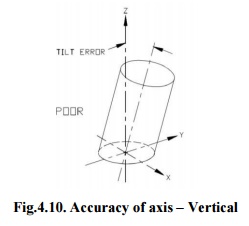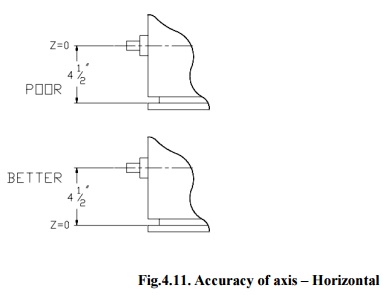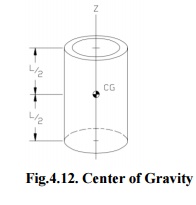Chapter: Mechanical : Computer Aided Design : Assembly of Parts
Mass property calculations
Mass property calculations
The first step in finding mass properties is to set
up the location of the X, Y, and Z axis. The correctness of the calculations
will depend completely on the knowledge used in choosing the axis.
Hypothetically, these axes can be at any position relative to the object being
considered, offered the axes are equally perpendicular. But, in reality, except
the axes are chosen to be at a position that can be precisely measured and
identified, the calculations are meaningless.

Fig.4.10.
Accuracy of axis –Vertical
As shown in the figure 4.10, the axes do not create
a best reference hence a small error in squareness of the base of the cylinder
origins the object to tilt away from the vertical axis.

Fig.4.11.
Accuracy of axis –Horizontal
An axis should always pass via a surface that is
firmly linked with the bulk of the component. As shown in the figure 4.11, it
would be best to position the origin (Z=0) at the end of the component rather
than the fitting that is freely dimensioned virtual to the end.
1. Calculating Center of gravity
location
The center of gravity of an object is:
·
described the ‘center of mass’of the
object.
·
the location where the object would
balance.
·
the single point where the static
balance moments are all zero about three mutually perpendicular axis.
·
the centroid of object the volume when
the object is homogeneous.
·
the point where the total mass of the
component could be measured to be concentrated while static calculations.
·
the point about where the component
rotates in free space
·
the point via the gravity force can be
considered to perform
·
the point at which an exterior force
must be used to create translation of an object in space
Center of gravity
location is stated in units of length along the three axes (X, Y, and Z). These
three components of the vector distance from the base of the coordinate system
to the Center of gravity location. CG of composite masses is computed from
moments considered about the origin. The essential dimensions of moment are
Force and Distance. On the other hand, Mass moment may be utilized any units of
Mass times Distance. For homogeneous components, volume moments may also be
considered. Care should be taken to be confident that moments for all parts are
defined in compatible units.
Component distances for CG position may be either
positive or negative, and in reality their polarity based on the reference axis
position. The CG of a homogeneous component is determined by determining the
Centroid of its volume. In practical, the majority of components are not
homogeneous, so that the CG must be calculated by adding the offset moments
along all of the three axes.

Fig.4.12. Center of Gravity
Related Topics